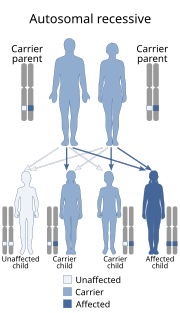
Down syndrome, also known as trisomy 21, is a genetic disorder caused by the presence of all or part of a third copy of chromosome 21. It is usually associated with physical growth delays, mild to moderate intellectual disability, and characteristic facial features. The average IQ of a young adult with Down syndrome is 50, equivalent to the mental ability of an 8- or 9-year-old child, but this can vary widely.

Asperger syndrome (AS), also known as Asperger's, is a developmental disorder characterised by significant difficulties in social interaction and nonverbal communication, along with restricted and repetitive patterns of behavior and interests. As a milder autism spectrum disorder (ASD), it differs from other ASDs by relatively normal language and intelligence. Although not required for diagnosis, physical clumsiness and unusual use of language are common. Signs usually begin before two years of age and typically last for a person's entire life.

Tourette syndrome is a common neurodevelopmental disorder with onset in childhood, characterized by multiple motor tics and at least one vocal (phonic) tic. These tics characteristically wax and wane, can be suppressed temporarily, and are typically preceded by an unwanted urge or sensation in the affected muscles. Some common tics are eye blinking, coughing, throat clearing, sniffing, and facial movements. Tourette's does not adversely affect intelligence or life expectancy.
Hypotonia, commonly known as floppy baby syndrome, is a state of low muscle tone, often involving reduced muscle strength. Hypotonia is not a specific medical disorder, but a potential manifestation of many different diseases and disorders that affect motor nerve control by the brain or muscle strength. Hypotonia is a lack of resistance to passive movement, whereas muscle weakness results in impaired active movement. Central hypotonia originates from the central nervous system, while peripheral hypotonia is related to problems within the spinal cord, peripheral nerves and/or skeletal muscles. Recognizing hypotonia, even in early infancy, is usually relatively straightforward, but diagnosing the underlying cause can be difficult and often unsuccessful. The long-term effects of hypotonia on a child's development and later life depend primarily on the severity of the muscle weakness and the nature of the cause. Some disorders have a specific treatment but the principal treatment for most hypotonia of idiopathic or neurologic cause is physical therapy, occupational therapy for remediation, and/or music therapy.

Chédiak–Higashi syndrome is a rare autosomal recessive disorder that arises from a mutation of a lysosomal trafficking regulator protein, which leads to a decrease in phagocytosis. The decrease in phagocytosis results in recurrent pyogenic infections, albinism and peripheral neuropathy.
ICD-10 is an international statistical classification used in health care and related industries.
Rab27 is a member of the Rab subfamily of GTPases. Rab27 is post translationally modified by the addition of two geranylgeranyl groups on the two C-terminal cysteines.

Griscelli syndrome is a rare autosomal recessive disorder characterized by albinism (hypopigmentation) with immunodeficiency, that usually causes death by early childhood. Researchers have developed three different classifications of the form of disorder, characterised by different signs and symptoms. Type 1 Griscelli Syndrome is assosciated with severe brain function issues along with distinctive discolouring of the hair and skin. Type 2 Griscelli Syndrome have immune system abnormalities in addition to hypopigmentation of skin and hair. Finally, Type 3 is seen as those only affected by hypopigmentation of the skin and hair. This type is not associated with immune deficiencies or neurological abnormalities.
Neonatal-onset multisystem inflammatory disease is a rare genetic periodic fever syndrome which causes uncontrolled inflammation in multiple parts of the body starting in the newborn period. Symptoms include skin rashes, severe arthritis, and chronic meningitis leading to neurologic damage. It is one of the cryopyrin-associated periodic syndromes.

Hemophagocytic lymphohistiocytosis, also known as haemophagocytic lymphohistiocytosis, and hemophagocytic or haemophagocytic syndrome, is an uncommon hematologic disorder seen more often in children than in adults. It is a life-threatening disease of severe hyperinflammation caused by uncontrolled proliferation of activated lymphocytes and macrophages, characterised by proliferation of morphologically benign lymphocytes and macrophages that secrete high amounts of inflammatory cytokines. It is classified as one of the cytokine storm syndromes.

Guillain–Barré syndrome (GBS) is a rapid-onset muscle weakness caused by the immune system damaging the peripheral nervous system. The initial symptoms are typically changes in sensation or pain along with muscle weakness, beginning in the feet and hands. This often spreads to the arms and upper body, with both sides being involved. The symptoms develop over hours to a few weeks. During the acute phase, the disorder can be life-threatening, with about 15% developing weakness of the breathing muscles requiring mechanical ventilation. Some are affected by changes in the function of the autonomic nervous system, which can lead to dangerous abnormalities in heart rate and blood pressure.

Melanophilin is a carrier protein which in humans is encoded by the MLPH gene. Several alternatively spliced transcript variants of this gene have been described, but the full-length nature of some of these variants has not been determined.

Myosin-Va is a protein that in humans is encoded by the MYO5A gene.

Ras-related protein Rab-27A is a protein that in humans is encoded by the RAB27A gene.

Elejalde syndrome is an extremely rare autosomal recessive syndrome consisting of moderate pigment dilution, profound primary neurologic defects, no immune defects, and hair with metallic silvery sheen.

Griscelli syndrome type 2 is a rare autosomal recessive syndrome characterized by variable pigmentary dilution, hair with silvery metallic sheen, frequent pyogenic infections, neutropenia, and thrombocytopenia.

Lavender or self-blue refers to a plumage color pattern in the chicken characterized by a uniform, pale bluish grey color across all feathers. The distinctive color is caused by the action of an autosomal recessive gene, commonly designated as "lav", which reduces the expression of eumelanin and phaeomelanin so that black areas of the plumage appear pale grey instead, and red areas appear a pale buff.












